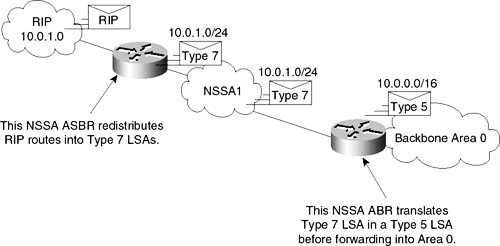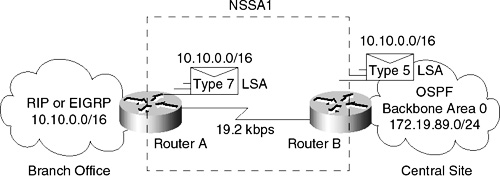Designing Implementing an OSPF Network
Configuring OSPF Area ParametersCisco OSPF software enables you to configure several area parameters. These area parameters include authentication, defining stub areas, and assigning specific costs to the default summary route. Authentication allows password-based or key-based protection against unauthorized access to an area. Stub areas are areas into which information on external routes is not sent. Instead, there is a default external route generated by the area border router, into the stub area for destinations outside the autonomous system. To further reduce the number of link-state advertisements sent into a stub area, you can configure no-summary on the ABR to prevent it from sending summary link advertisement (LSA Type 3) into the stub area. In router configuration mode, specify any of the following area parameters as needed for your network:
Configuring OSPF Not-So-Stubby Areas (NSSAs)NSSAs are similar to regular OSPF stub areas, except that an NSSA does not flood Type 5 external LSAs from the core into the not so stubby area, but it has the capability to import AS external routes in a limited fashion within the area. Prior to NSSA, the connection between the corporate site border router and the remote router could not be run as OSPF stub area because routes for the remote site cannot be redistributed into stub area. A simple protocol like RIP is usually run to handle the redistribution. This has meant maintaining two routing protocols. With NSSA, you can extend OSPF to cover the remote connection by defining the area between the corporate router and the remote router as an NSSA. Figure 7-20 illustrates the overall operation of an OSPF NSSA.
NSSA allows importing of Type 7 AS external routes within NSSA area by redistribution. These Type 7 LSAs are translated into Type 5 LSAs by NSSA ABR which are flooded throughout the whole routing domain. Summarization and filtering are supported during the translation. If you are an Internet Service Provider (ISP), or a network administrator who has to connect a central site using OSPF to a remote site that is using a different protocol, such as RIP or EIGRP, you can use NSSA to simplify the administration of this kind of topology. Before NSSA, the connection between the corporate site ABR and the remote router used RIP or EIGRP. This meant maintaining two routing protocols. Now, with NSSA, you can extend OSPF to cover the remote connection by defining the area between the corporate router and the remote router as an NSSA, as shown in Figure 7-21. You cannot expand the normal OSPF area to the remote site because the Type 5 external will overwhelm both the slow link and the remote router.
NSSA Implementation Considerations Evaluate the following considerations before implementing NSSA:
If possible, avoid using explicit redistribution on NSSA ABRs because confusion might result over which packets are being translated by which router. In router configuration mode, specify the following area parameters as needed to configure and define the OSPF NSSA: area area-id nssa [no-redistribution] [default-information-originate] In router configuration mode on the ABR, specify the following command to control summarization and filtering of Type 7 LSA into Type 5 LSA during the translation process: summary address prefix mask [not advertise] [tag tag] Configuring Route Summarization Between OSPF AreasIn OSPF, an ABR will advertise addresses that describe how to reach networks (routes) from one area into another area. Route summarization is the consolidation of these advertised addresses. This feature causes a single summary route to be advertised to other areas by an ABR, thereby representing multiple routes in a single statement. This has several benefits, but the primary one is a reduction in the size of routing tables. If the network numbers in an area are assigned in such a way that they are contiguous, you can configure the ABR to advertise a summary route that covers all the individual networks within the area that fall into the range specified by the summary route. To specify an address range, perform the following task in router configuration mode: area area-id range address mask Configuring Route Summarization when Redistributing Routes into OSPF When redistributing routes from other protocols into OSPF, each route is advertised individually in an external link-state advertisement (LSA). However, you can configure OSPF to advertise a single route for all the redistributed routes that are covered by a specified network address and mask. Doing so helps decrease the size of the OSPF link-state databases and in turn the routing table. The same benefits discussed in route summarization between areas is applicable here, only now the routes are coming from an external source. To have OSPF advertise one summary route for all redistributed routes covered by a network address and mask, perform the following task in router configuration mode: summary-address address mask
|
EAN: 2147483647
Pages: 200

